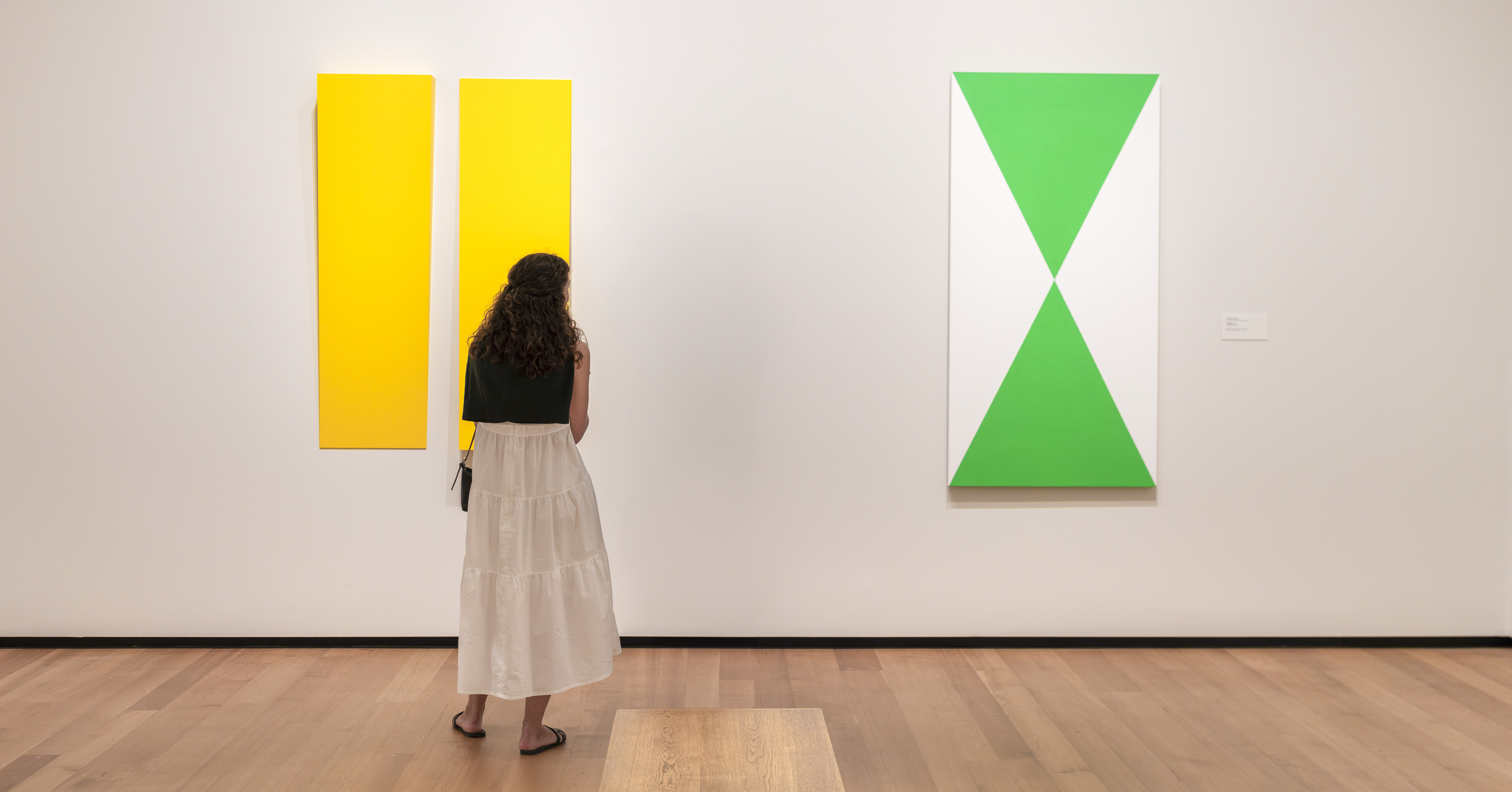Use our guide to explore works by Latinx artists on view in our galleries.
Discover how they’ve addressed histories, represented communities, and honored traditions through their works.
Take this guide with you through the galleries. You will need a map. Pick one up at any information desk or use our app. Stay tuned—more works by Latinx artists will be on view in September and October in our exhibitions Spirit & Strength: Modern Art from Haiti and The ’70s Lens: Reimagining Documentary Photography.
Estimated time for the tour: 45 minutes
East Building
Carmen Herrera, Untitled Estructura (Yellow)

Carmen Herrera conceived her series of Estructuras (Structures) in the 1960s. Untitled Estructura (Yellow) features two triangular wedges that hang side by side. The wedges are reverses of each other: one narrows at the bottom and the other at the top. The slice of wall between them becomes part of the work. Herrera’s art often makes us question where the painting begins and ends.
Herrera studied art and architecture in Havana, Cuba, before moving to New York City in 1939. Living there and in Paris, Herrera developed a distinct style of crisp and vividly colorful paintings. But the artist was nearly 90 years old before art world recognized her vision, which included bringing her paintings into three dimensions.
Upper Level, Gallery 406-A
Freddy Rodríguez, Casabe y Cruz II

This painting references the history of the Dominican Republic, where artist Freddy Rodríguez was born. Embellished with a cross, the circular canvas evokes communion bread—typically a flat white wafer. In the Catholic ritual of the Eucharist, the bread stands in for the body of Jesus Christ. But the painting also resembles casabe, a bread derived from yuca roots of the cassava plant. The bread is popular across the Caribbean and Latin America as well as their diasporas.
Rodríguez merges these two foods, alluding to the Christian colonization of the island of Hispaniola. Using the color white, the artist also references the colonizers’ desire to purify Indigenous and African religions and traditions.
Upper Level, Gallery 406
Dino Aranda, Three Figures (Tres Figuras)

In Three Figures (Tres Figuras), Dino Aranda depicts three abstracted human bodies in coffin- or cage-like forms. The painting is part of a haunting series he made in response to the murder of students during the Somoza dictatorship. The Somoza family ruled the artist’s native Nicaragua from 1936 to 1979.
Aranda played a key role in establishing Managua, Nicaragua’s capital, as a center of Latin American art in the 1960s. In 1965, he moved to Washington, DC, to study at the Corcoran School of Art. There, Aranda cofounded Fondo del Sol Visual Arts Center. The gallery presented the work of Latin American and Latinx artists, organizing traveling exhibitions across the United States and Mexico.
Upper Level, Gallery 407
West Building
Sophie Rivera, Untitled

Bathed in light against a dark background, each of Sophie Rivera’s sitters addresses the viewer directly. Rivera’s portrait series features fellow New Yorkers of Puerto Rican heritage, known as Nuyoricans. To find her subjects, she asked passersby in her Harlem neighborhood if they were Puerto Rican. If they said yes, she invited them to have their pictures taken in her home. The sitters’ grace and dignity reflect the trust between artist and subject.
Rivera defined herself as “an artist, Latino, and feminist.” She sought to make Nuyoricans part of the grand history of American portrait photography. “I have attempted to integrate my cultural heritage into an artistic continuum,” Rivera said.
Ground Floor, Gallery 41
Frank Espada, Mother and Daughter, Hartford, Connecticut

For The Puerto Rican Diaspora Documentary Project, Frank Espada photographed Puerto Ricans across the country. Portraits such as Mother and Daughter honestly capture the diaspora—and those who returned to Puerto Rico. (Espada himself migrated from Puerto Rico to New York at age 9.) The artist focused on subjects whom he considered personal heroes—people who worked to improve themselves and their communities.
Made between 1970 and 2000, the project includes thousands of photographs of Puerto Ricans in their homes, workplaces, and communities. It spans from Honolulu, Hawaii, to Hartford, Connecticut. A community organizer as well as an artist, Espada also collected more than 100 oral histories. (They are now in the archives of Smithsonian’s National Museum of American History.)
Ground Floor, Gallery 29
Ana Mendieta, Untitled

Cuban American artist Ana Mendieta sought to reconnect with essential natural elements through her art. For the Silueta series (Silhouette series), Mendieta took photographs of her body in landscapes. In some images, she is covered in natural materials. Others show the outline her body left on the terrain.
Mendieta explored our connection to the environment and to our place in the universe. “My art is grounded on the belief in one universal energy which runs through all being and matter, all space and time,” she said. Her groundbreaking works blend performance, photography, video, and more.
Ground Floor, Gallery 31
Sculpture Garden
Alfredo Halegua, America

Alfredo Halegua initially didn’t name this 25-foot sculpture. Nearly two decades after its creation, he added the title America, which is inspired by the form of the work. Halegua said that the bend near its base reminded him of something that grew with great difficulty at first, but resulted in “something positive”—like the United States.
The Washington, DC–based sculptor, born in Uruguay, creates large-scale abstract sculptures using materials like steel and metal. He focuses on geometric abstraction and on the two-dimensionality of lines and forms. The artist has experimented for decades with clean lines, sharp angles, and negative space. Halegua’s public artworks are on view across the United States.
